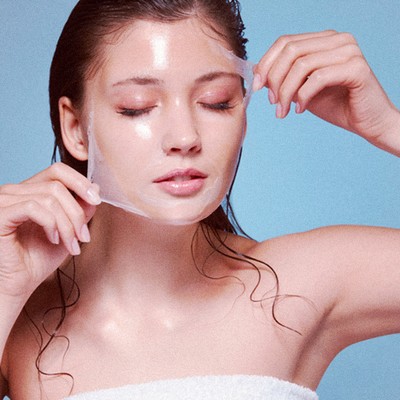
Chemical Peels vs. Laser Treatment: Which Is Best For You?
Each One Is An Entirely Different Process
“Let’s start with lasers,” says Debbie Thomas, advanced skin & laser expert. “They trigger chemical reactions in your skin cells. The most common reaction from light-based treatments is based around a thermal reaction (heat), which promotes healing, while destroying pigment and cauterising veins – plus, many other things. Most people describe the sensation of the laser as a short sharp flick or shock with some tingling after. Depending on what we are treating we may only apply the laser to a targeted patch, or we might cover the whole area.” Founder of British Aesthetics Dr. Bibi Ghalaie adds: “As for chemical peels, this is a solution of acids that can be applied directly to the surface of skin to exfoliate, remove damaged cells and then cause them to peel away. Think of them as a form of ‘chemical exfoliation.’ They can be used to treat issues like wrinkles, fine lines, scars, redness and melasma to name a few. Available as liquids, you apply them to the skin and leave for roughly 20 minutes. After this, they’re washed off or neutralised with another liquid solution.”
They Challenge The Skin Differently
“Both lasers and chemical peels can be used to treat pigmentation, acne, scarring, freckling, sun damage and improve fine lines and wrinkles,” explains Dr. Bibi. “There is overlap in their uses but there are some major differences, too. Lasers are a more expensive option, often costing several hundred pounds per treatment. They target and remove one layer of skin at a time, whereas peels can cover a much larger area of skin in one go. Peels are great for superficial irregularities but for deeper wrinkling, deeper pigmentation and blood vessel or vein concerns, lasers are more appropriate. Some peels can be performed at home, whereas most laser treatments need to be done in a medical setting.”
Neither Are One Size-Fits-All
“The decision to have a chemical peel or a laser depends on your skin type and individual skin concerns,” says Dr. Bibi. “For hyperpigmentation and more superficial skin concerns, a chemical peel is better, but to achieve changes in texture and for scarring and deeper skin damage, lasers work better. Neither procedure is suitable if there is any active skin infection or if someone has a history of keloids or hypertrophic scars. It’s also worth noting that some of these treatments may not be suitable for people with darker skin tones. Medium peels can be too aggressive for black skin, while deep peels can risk severe scarring, so it’s always key to seek advice before undergoing either procedure – there are always options, but it needs to be safe.”
You Can Often Combine The Two
“There are so many types of lasers and peels that it’s essential you have a consultation first before having either,” advises Debbie. “Especially if you have sensitive, problematic, or darker skin. Both peels and lasers can help with many skin issues but mostly in very different ways. Often, they combine well to give even better results, but it’s worth noting that they both need maintenance, so to maintain results you'll need to invest regularly.”
Both Require Different Lengths Of Downtime
“It depends on the type and strength of each treatment, but typically light peels can leave skin inflamed for four to seven days, while deep peels can cause severe redness and swelling with up to two weeks of downtime,” explains Dr. Bibi. “As for lasers, swelling and redness varies and can last for just a few hours or a week. Generally, though, most in-clinic laser treatments leave the skin a little warm and sometimes inflamed for a maximum of 24 hours. It goes without saying that the skin should not be exposed to the sun after either treatment.”
One Can Be More Intense Than The Other
“The most powerful chemical peel is a phenol peel,” says Dr. Bibi. “This is a powerful exfoliant which penetrates the deeper layers of the skin to target wrinkling and discolouration. But even this peel does not compare to the ability of ablative lasers, particularly fractional ablative lasers – like Fraxel and carbon dioxide lasers. These are much more intense and can generate much deeper changes in the skin in terms of winkle repair and textural improvement – even if it is over a longer period.”
Always Use A Well-Regarded Professional
“The most important thing to remember is that, in the wrong hands, you run the risk of things going wrong, while repairing the damage can often cost a lot more than the original treatment itself,” Debbie warns. “In the right experienced hands, these treatments can be life-changing, I have seen skin transform before my eyes, and the confidence it restores in my clients. These treatments are not a cure-all and they do not work miracles, but with patience and realistic expectations, they are worth the money.”
Side Effects Come With Both
“There are always risks with active treatments and products,” finishes Debbie. “Both lasers and peels are designed to stimulate and activate reactions within the skin. While we usually have good control over the treatments, there's always the odd occasion when someone reacts differently. This can be due to lots of things: medication, lifestyle choices, simple DNA. It is possible to get rashes, redness, swelling, pigmentation changes, burns and scars. While this sounds scary, most of them are extremely rare, and by going to an experienced and reputable clinic you have a much higher chance of avoiding these reactions. For the most part these side-effects clear up within a few days so always speak to your treatment provider if you feel like you've had a bad reaction.”
5 Of The Best Clinics To Try For Lasers & Peels…
DISCLAIMER: We endeavour to always credit the correct original source of every image we use. If you think a credit may be incorrect, please contact us at info@sheerluxe.com.